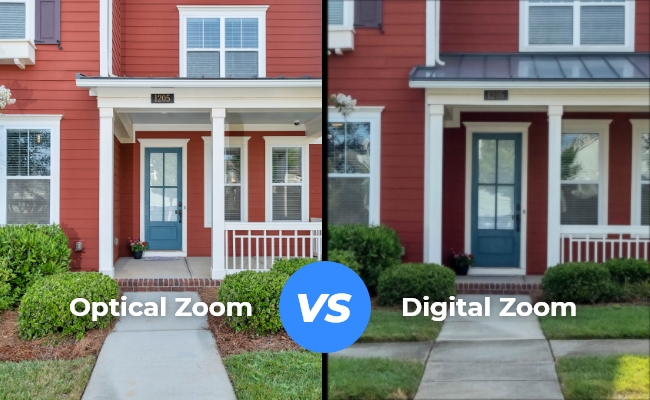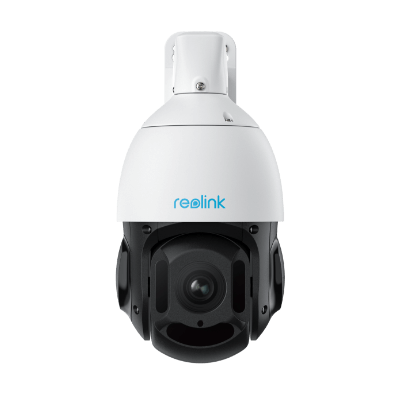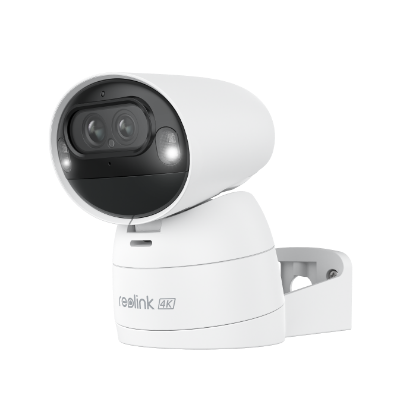Optical vs. Digital Zoom: Which One You Choose?

When it comes to zooming in on things with your home security camera, you might have heard about two types: optical zoom and digital zoom. But what's the difference, and which one should you choose? Let's break it down in simple terms to help you understand and make the right choice for your pictures.
Optical vs. Digital Zoom: Key Differences Between Them
The main difference between optical and digital zoom is in the image zooming way. Optical zoom achieves accurate zooming by physically adjusting the lens, providing genuine magnification. In contrast, digital zoom captures the entire field of an object and allows you to focus on specific details by cropping out the extraneous parts.
Let's see other differences in the following list:
What is Digital Zoom?
Digital zoom is a software-based feature commonly found in cameras like smartphones, digital cameras, and some video cameras. Unlike optical zoom, which adjusts physical lenses to zoom in on a subject, digital zoom enlarges the existing image digitally. However, it's crucial to recognize that digital zoom needs to provide the same level of detail as optical zoom.
In contrast to optical zoom's actual magnification achieved through lens adjustments, digital zoom lacks any physical movement of lenses. Instead, it digitally enlarges the captured image, resulting in no genuine magnification or improvement in resolution.
While digital zoom can create the illusion of getting closer to an object, it comes at a cost—significant loss of image quality, especially when pushing beyond the camera's optical zoom capabilities. The process involves enlarging the existing image, leading to pixelation and a reduction in sharpness.
To mitigate the quality loss caused by digital enlargement, cameras often employ interpolation—a technique that estimates pixel values to fill in the gaps. Despite this, the result may be a more pixelated or blurry image.
What is Optical Zoom?
Optical zoom, the traditional method of zoom, utilizes the optics of zoom lenses to bring the subject closer to the image sensor without sacrificing image quality.
One of the key advantages of optical zoom is that it maintains the same resolution throughout the zooming process. The lens physically adjusts to change the magnification, ensuring there is no loss of detail or clarity in the captured image.
In contrast to digital zoom, optical zoom provides superior image quality by magnifying the image optically. It captures more details without relying on digital interpolation, avoiding issues like pixelation or a reduction in sharpness.
Optical zoom capabilities are often expressed as a numerical ratio, such as 3x, 5x, or 10x, indicating how much the lens can magnify the image. Different lenses can achieve various optical zoom ranges, allowing users to choose a level of magnification suitable for their needs.
Optical vs. Digital Zoom: Pros and Cons
In comparing optical and digital zoom, it's essential to weigh the distinct advantages and disadvantages of each approach to zoom functionality. Let's explore the pros and cons of them.
Pros and cons of digital zoom
Pros of digital zoom:
-
Convenience and accessibility: Digital zoom is often more convenient and accessible, especially in devices with limited physical space for complex zoom mechanisms.
-
Compact design: Devices with digital zoom can maintain a compact and lightweight design since they don't require the mechanical components associated with optical zoom.
-
Cost-effective: Devices with digital zoom tend to be more cost-effective, making them accessible to a broader range of users.
Cons of digital zoom:
-
Loss of image quality: The most significant drawback of digital zoom is the potential loss of image quality. Enlarging the image digitally can result in pixelation, reduced sharpness, and overall degradation.
-
No true magnification: Digital zoom doesn't provide true magnification since it doesn't involve physical adjustments to the lenses.
-
Interpolation artifacts: Digital zoom often relies on interpolation to fill in gaps, leading to artifacts and a less natural appearance in the enlarged image.
-
Inferior performance in low light: Digital zoom may perform poorly in low-light conditions, as the process of digitally enlarging an image can amplify noise and reduce image clarity.
-
Less suitable for professional use: Digital zoom is generally less suitable for professional photography or videography, where maintaining the highest image quality is paramount.
Pros and Cons of Optical Zoom
Pros of optical zoom:
-
Maintained image quality: Optical zoom maintains high image quality throughout the zooming process as it physically adjusts the lens elements without resorting to digital manipulation.
-
True magnification: It provides true magnification, allowing you to bring distant subjects closer without sacrificing clarity or introducing pixelation.
-
Enhanced detail capture: Optical zoom captures more details without the need for digital interpolation, resulting in sharper and more detailed images.
-
Preferred for professional use: Optical zoom is favored in professional settings, such as photography and videography, where maintaining the highest possible image quality is crucial.
Cons of optical zoom:
-
Bulkier design: Devices with optical zoom mechanisms may be bulkier due to the physical movement of lenses, impacting the portability of the device.
-
Cost: Cameras with optical zoom tend to be more expensive, especially those with higher magnification capabilities or advanced lens technologies.
Optical vs. Digital Zoom: Which is Better to Use?
Although the optical zoom shows better image quality and sharpness in comparison, it's important to consider specific use cases and individual preferences when choosing between the two.
When to use the camera with optical zoom?
-
Professional photography: In professional photography, optical zoom is preferred for capturing high-quality images with true magnification, ensuring that fine details are preserved without compromising clarity.
-
Wildlife photography: Optical zoom allows photographers to maintain a safe distance while capturing intricate details of animals in their natural habitats.
-
Event photography: Optical zoom is valuable in event photography, such as weddings or concerts, where the ability to zoom in on distant subjects without sacrificing image quality is crucial for capturing memorable moments.
-
Portrait photography: For portrait photography, optical zoom helps achieve a flattering perspective without distortion, allowing photographers to frame their subjects effectively.
When to use the camera with digital zoom?
- Casual photography: For casual photographers who prioritize convenience, digital zoom in point-and-shoot cameras or smartphones can be suitable for everyday snapshots without the need for intricate zoom controls.
- Social media sharing: For social media sharing, where users may want to zoom in on details before sharing images without the need for professional-grade image quality, digital zoom is convenient.
Other Camera Zoom Types Explained: Hybrid Zoom
Hybrid zoom, a recent innovation in smartphone cameras, seamlessly blends optical and digital zoom with advanced algorithms. When optical zoom reaches its limit, hybrid zoom smoothly transitions to digital zoom for optimal results.
Smartphones with optical zoom typically offer 3x to 5x capabilities. However, when shooting scenarios require a focal length beyond optical zoom's limits, hybrid zoom steps in. It intelligently combines optical and digital zoom to mitigate distortion and enhance image quality.
While algorithms vary, the core concept remains consistent. Hybrid zoom uses software enhancements to synthesize images from multiple photos, akin to night mode and HDR effects, with a primary focus on adjusting focal length.
Manufacturers leverage diverse sensors and focal lengths, employing intelligent algorithms to enhance magnification. Though not true optical zoom, hybrid zoom surpasses ordinary digital zoom by preserving crucial details within a specific distance, offering users a versatile and efficient zooming solution for various shooting scenarios.
Optical Zoom in Security Camera: Best Recommendation
Optical zoom and digital zoom are also often used in the field of security cameras. However, optical zoom is usually preferable in security cameras. Because like other cameras, optical zoom in security camera can let you zoom in to view more image details or zoom out to get a wider viewing angle without compromising the image quality.
Now I will introduce you 2 popular optical zoom security cameras.
The best PoE optical zoom security camera - RLC-811A
RLC-811A, a 4K Smart PoE Camera featuring a 5X Optical Zoom. Unlike digital zoom, this optical marvel ensures unparalleled detail without sacrificing clarity. Every frame is a masterpiece, capturing 4K visuals that redefine surveillance.
What's more, RLC-811A features PoE technology, streamlining the installation process by combining power and data into a single cable. This not only reduces cable clutter but also ensures a stable and reliable connection.
4K Smart PoE Camera with 5 Spotlights
4K 8MP Ultra HD Day & Night, Person/Vehicle Alerts, 5X Optical Zoom, Two-Way Audio, Built-in Siren, Color Night Vision, Live View Anywhere.
The best PTZ optical zoom security camera - RLC-823A 16X
If you want a higher optical zoom security camera, RLC-823A 16X is a good choice for you.
RLC-823A 16X is a 4K PTZ security camera with 16X optical zoom function. This advanced optical capability allows you to magnify and scrutinize distant subjects with remarkable precision. Its 4K resolution ensures each frame is a masterpiece of clarity and detail. The PTZ functionality adds another layer of versatility, providing the freedom to pan, tilt, and zoom, ensuring comprehensive coverage of your monitored area.
Smart PTZ PoE Camera with Spotlights
4K 8MP Ultra HD, Person/Vehicle Detection, 16X Optical Zoom, Auto Tracking, Manual Pan & Tilt, Two-Way Audio, 190ft Night Vision, Live View.
The best wireless PT hybrid zoom security camera - Argus Track
If you want a wireless PTZ security camera, Argus Track is the right choice.
Reolink Argus Track is a 4K battery dual-lens security camera.With its 4K 8MP Ultra HD resolution, you get crystal-clear footage for detailed analysis. Its Pan, Tilt & 6X Hybrid Zoom feature enables precise monitoring, while Color Night Vision ensures visibility even in low-light conditions. Plus, with its 5/2.4 GHz Dual-Band Wi-Fi connectivity, you can rely on seamless performance.
4K Dual-Lens Wi-Fi Solar/Battery Camera
4K 8MP Ultra HD, Auto-Zoom Tracking, Pan, Tilt & 6X Hybrid Zoom, Color Night Vision, Dual-Band Wi-Fi.
FAQs
1. Does optical zoom reduce image quality?
No, optical zoom does not reduce the quality of an image. In fact, optical zoom is designed to maintain image quality even as you zoom in. Optical zoom involves adjusting the physical focal length of the camera lens to bring the subject closer, capturing more details without relying on digital manipulation.
2. What do 4X/5X/10x/20X optical zoom mean?
Specifications like 4X, 5X, 10X, or 20X optical zoom indicate the camera's ability to physically magnify the image. For instance, 4X means the lens can bring the subject four times closer without compromising image quality.
3. What is a good zoom range for a camera?
The ideal zoom range for a camera depends on your specific needs and use cases. However, a versatile zoom range is often considered beneficial for various situations. For digital cameras and smartphones, a zoom range of around 3X to 10X is common and can be suitable for general photography.
For more specialized purposes, such as wildlife or sports photography, a camera with a higher zoom range, such as 20X or more, might be preferable. Professional cameras, especially those designed for wildlife and sports photography, can have even more extensive zoom ranges.
Conclusion
When comparing optical and digital zoom, the verdict leans strongly in favor of optical zoom for most scenarios. Optical zoom, achieved through the physical movement of lenses, maintains image quality even as you zoom in, providing clear and detailed shots.
On the other hand, digital zoom, while convenient, often leads to a loss of quality as it digitally enlarges the existing image. The choice between the two ultimately depends on your specific needs.
If you like this article and find it helpful, share it with your friends. Do you have something to say about optical or digital zoom? Make sure you leave a comment below!
Search
Subscribe for the Latest Updates
Security insights & offers right into your inbox



